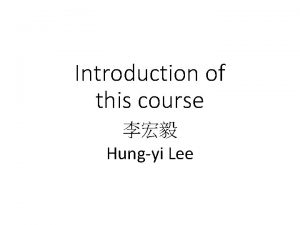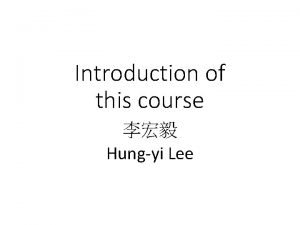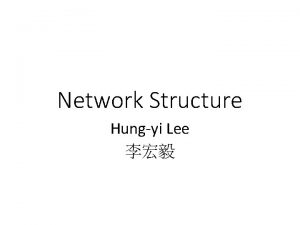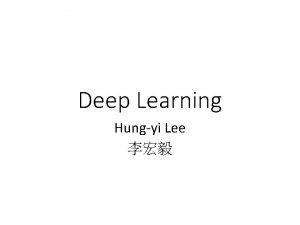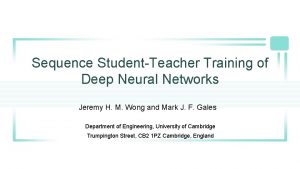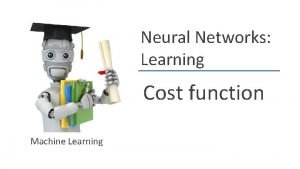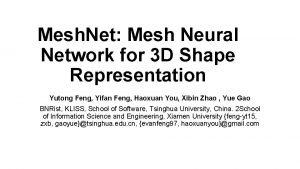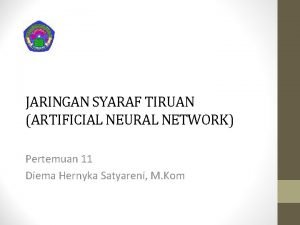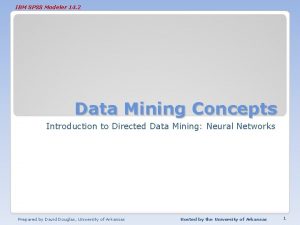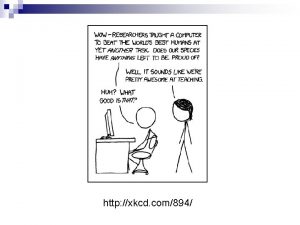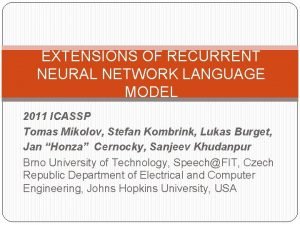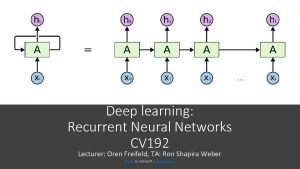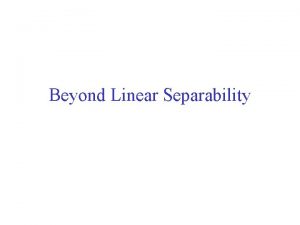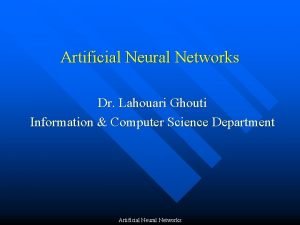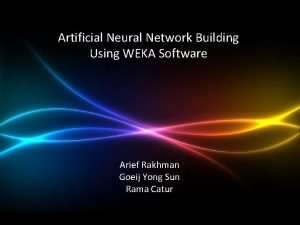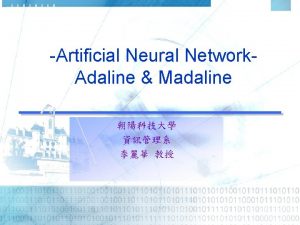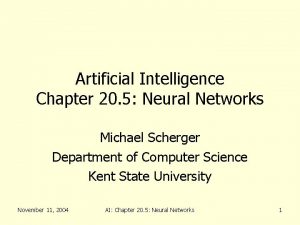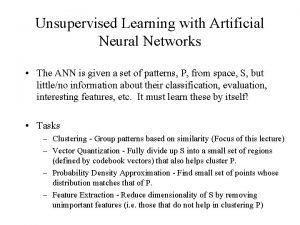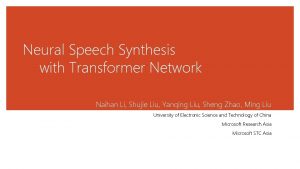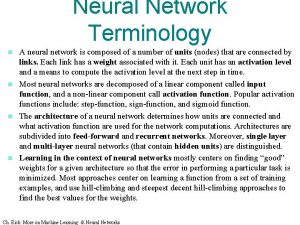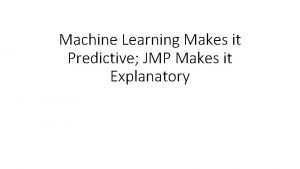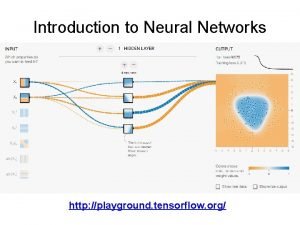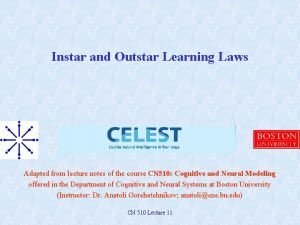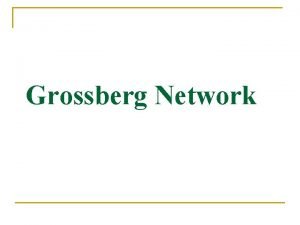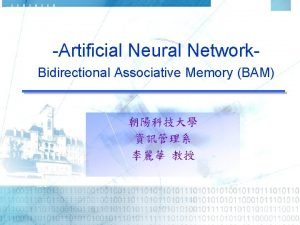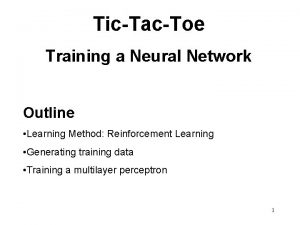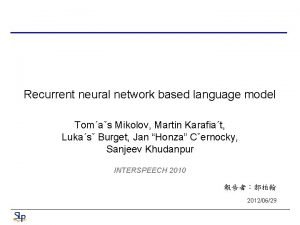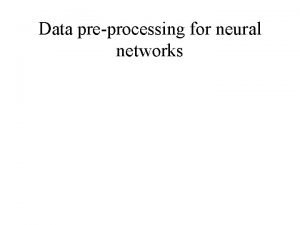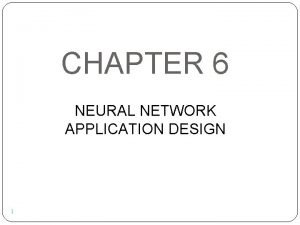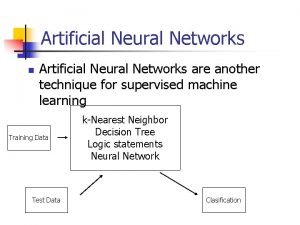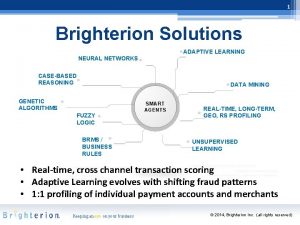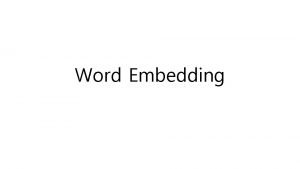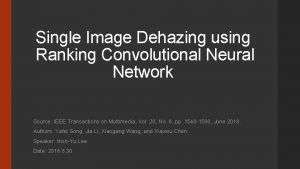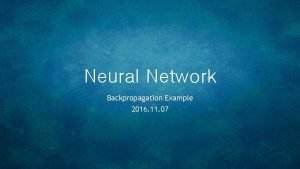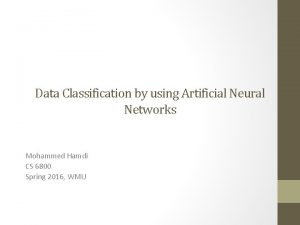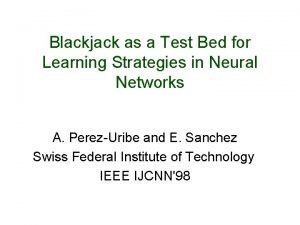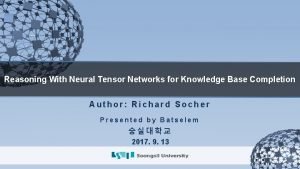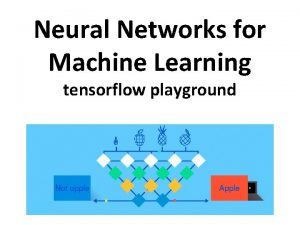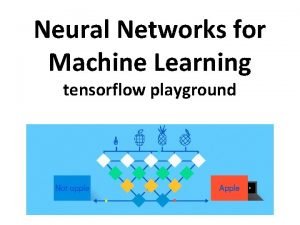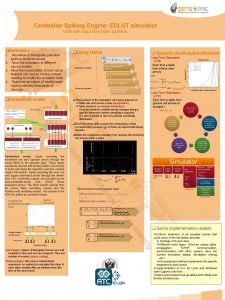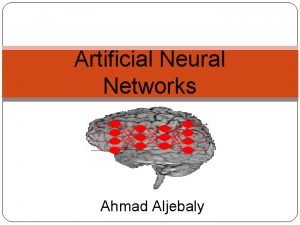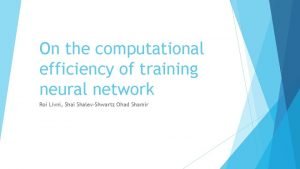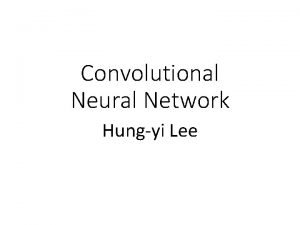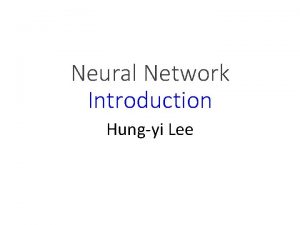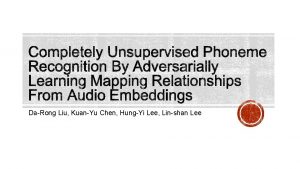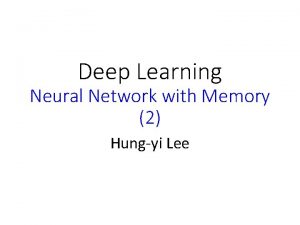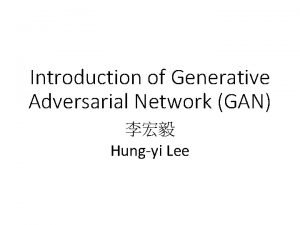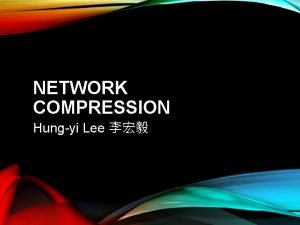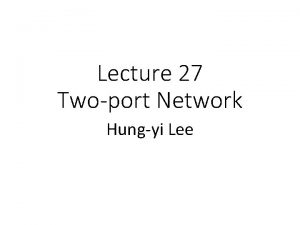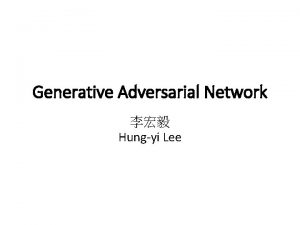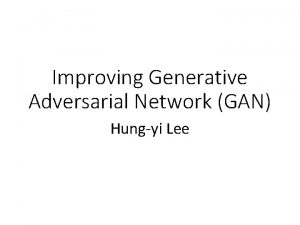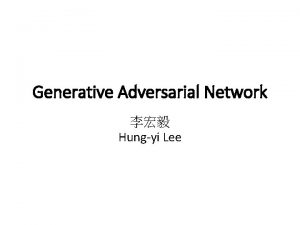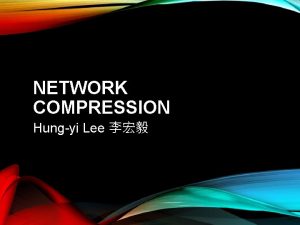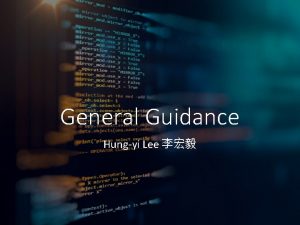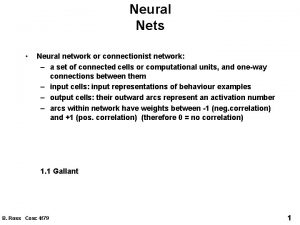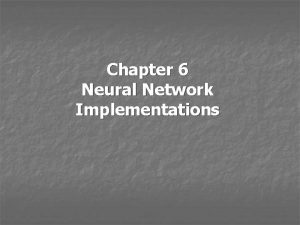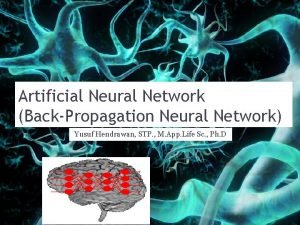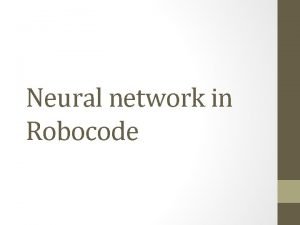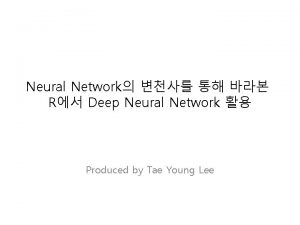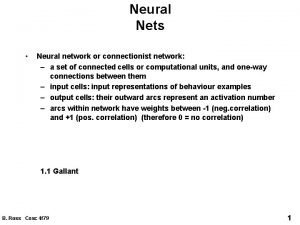More Tips for Training Neural Network Hungyi Lee






























































































- Slides: 94

More Tips for Training Neural Network Hung-yi Lee

Outline Activation Function Cost Function Data Preprocessing Training Generalization

Review: Training Neural Network •

Review: Gradient descent •

Review: Backpropagation Layer Error signal for backprop Layer Forward Pass Backward Pass … …

Review: Backpropagation Layer L-1 Layer L Error signal for backprop …… Backward Pass …… … … ……

Outline Activation Function Cost Function Data Preprocessing Training Generalization

Problem of Sigmoid Function Derivative of Sigmoid Function is always smaller than 1

Vanishing Gradient Problem Backward Pass: Layer L-1 Layer L …… • Error signal is getting smaller and smaller …… … … …… Gradient is smaller … …

Vanishing Gradient Problem Input Layer 1 Layer 2 Layer L Output …… vector x …… …… …… vector y …… Learn very slowly Learn faster Still random Already converge … The weights are converged based on random!?

Re. LU • Rectified Linear Unit (Re. LU)

Re. LU Backward Pass: Layer L-1 Layer L …… …… … … ……

Re. LU Backward Pass: Layer L-1 Layer L …… 0 1 No 1 Attenuation 0 …… … … 0 0 … … ……

Re. LU Backward Pass: All the weights connected to this neuron will have zero gradient. Layer L 1 0 …

Maxout • Re. LU or PRe. Lu is just a special case of Maxout Input + + Max +

Maxout – Re. LU is special case Input Re. LU Input + Max +

Maxout – Re. LU is special case Input Re. LU Input + Max + Learnable Activation Function

Maxout - Training by Backpropagation • In forward pass, we know which z would be the max + + Input Max + + Max +

Maxout - Training by Backpropagation • In forward pass, we know which z would be the max + + Input + + + • In backward pass, treat it as network whose neurons having linear activation functions

Outline Activation Function Cost Function Data Preprocessing Training Generalization

Problem of Sigmoid …… …… … … Larger difference, Larger gradient …… … … tiny derivative How about ≈1 0 Large difference

Re. LU is probably not suitable for output layer Re. LU More similar? Only one dimension is 1, and others are all 0 Re. LU Ø Larger output means larger confidence It is better to let the output bounded. Better?

Softmax • Softmax layer as the output layer Ordinary Output layer

Softmax • Softmax layer as the output layer Softmax Layer 3 1 -3 0. 88 20 0. 12 2. 7 0. 05 ≈0

Softmax Define cost function Minimize … … … Softmax Only one dimension is 1, and others are all 0 … … … Index of the dimension which is 1

Softmax Define cost function Minimize Cross Entropy … … Softmax … … Don’t we have to decrease other dimensions?



Outline Activation Function Cost Function Data Preprocessing Training Generalization

Data Preprocessing For each dimension i: …… …… The means of all dimensions are 0, and the variances are all 1

Outline Activation Function Cost Function Data Preprocessing Training Generalization

Outline - Training Activation Function Cost Function Data Preprocessing Momentum Training Generalization Learning Rates

Outline - Training Activation Function Cost Function Data Preprocessing Momentum Training Generalization Learning Rates

Problem of Gradient descent cost Very slow at the plateau Gradient is small Stuck at local minima Gradient is Zero parameter space

In physical world …… • Momentum How about put this phenomenon in gradient descent?

Original Gradient descent Gradient Movement ……

Gradient descent with Momentum v 0=0 (vi : movement at the i-th update) Gradient Movement Momentum ……

Gradient descent with Momentum v 0=0 (vi : movement at the i-th update) v 0=0 …… ……

Gradient descent with Momentum cost Problem Gradient Movement Momentum Gradient = 0 parameter space

Gradient Movement NAG Momentum • Momentum Gradient = 0 • Nesterov’s Accelerated Gradient (NAG) Gradient = 0

Gradient descent, Momentum, NAG Methods: Gradient descent Momentum NAG Source: http: //www. cs. toronto. edu/~fritz/absps/momentum. pdf

Outline - Training Activation Function Cost Function Data Preprocessing Momentum Training Generalization Learning Rates

Learning Rates cost Very Large small Large Error Surface Just make epoch

Learning Rates • Not always true

Adaptive Learning Rates • Each parameter should have different learning rates Smaller Learning Rate Larger Gradient Larger Learning Rate Smaller Learning Rate

RProp • Each parameter should have different learning rates Gradient descent: 1 -1 Another Aspect:

RProp - Problem • RProp is problematic for stochastic gradient descent Gradient descent: 0. 1 1 Stochastic Gradient descent: 0. 9 -0. 1 -1 -1 -1

Adagrad • Divide the learning rate by “average” gradient Estimated while updating the parameters Larger learning rate Smaller learning rate

Adagrad

Adagrad • Divide the learning rate by “average” gradient • The “average” gradient is obtained while updating the parameters 1/t decay

RMSProp Error Surface can be complex in deep learning. Smaller Learning Rate Larger Learning Rate

RMSProp

http: //www. reddit. com/r/Machine. Learning/comments/2 gopfa/visual izing_gradient_optimization_techniques/cklhott (By Alec Radford)

http: //www. reddit. com/r/Machine. Learning/comments/2 gopfa/visual izing_gradient_optimization_techniques/cklhott (By Alec Radford)

Not the whole story …… • Adadelta • http: //www. matthewzeiler. com/pubs/google. TR 2012/go ogle. TR 2012. pdf • Adam • http: //arxiv. org/pdf/1412. 6980. pdf • Ada. Secant • http: //arxiv. org/pdf/1412. 7419 v 4. pdf • “No more pesky learning rates” • Using second order information • http: //arxiv. org/pdf/1206. 1106. pdf

Outline Activation Function Cost Function Data Preprocessing Training Generalization

Outline - Generalization Activation Function Cost Function Data Preprocessing Training Weight Decay Generalization Dropout

Outline - Generalization Activation Function Cost Function Data Preprocessing Training Weight Decay Generalization Dropout

Weight Decay • Our Brain

Weight Decay • The parameters closer to zero is preferred. Training data: … … Testing data: To minimize the effect of noise, we want w close to zero.

Weight Decay • New cost function to be minimized • Find a set of weight not only minimizing original cost but also close to zero Regularization term: Original cost (e. g. minimize square error, cross entropy …) (not consider biases. why? )

Weight Decay • New cost function to be minimized Gradient: Update: Smaller and smaller

Outline - Generalization Activation Function Cost Function Data Preprocessing Training Weight Decay Generalization Dropout

Dropout Training: (stochastic gradient descent) Ø In each iteration l Each neuron has p% to dropout

Dropout Training: (stochastic gradient descent) Thinner! Ø In each iteration l Each neuron has p% to dropout The structured of the network is changed. l Using the new network for training For each iteration, we resample the dropout neurons

Dropout Testing: Ø No dropout l If the dropout rate at training is p%, all the weights times (1 -p)%

Dropout - Intuitive Reason 我的 partner 會擺爛,所以 我要好好做 Ø When teams up, if everyone expect the partner will do the work, nothing will be done finally. Ø However, if you know your partner will dropout, you will do better. Ø When testing, no one dropout actually, so obtaining good results eventually.

Dropout - Intuitive Reason • Why the weights should multiply (1 -p)% (dropout rate) when testing? Training of Dropout Assume dropout rate is 50% Testing of Dropout No dropout Weights from training Weights multiply (1 -p)%

Dropout - Ensemble Training Set Ensemble Set 1 Set 2 Set 3 Set 4 Network 1 Network 2 Network 3 Network 4 Train a bunch of networks with different structures

Dropout - Ensemble Testing data x Network 1 Network 2 Network 3 Network 4 y 1 y 2 y 3 y 4 average

Dropout - Ensemble Training of Dropout x 2 x 1 Dropout ≈ Ensemble. x 3 x 4 M neurons …… 2 M possible networks Ø Using one data to train one network Ø Some parameters in the network are shared

Dropout - Ensemble Testing of Dropout ≈ Ensemble. testing data x …… All the weights multiply (1 -p)% y 1 y 2 average y 3 ? ≈ y

Dropout - Ensemble • Experiments on hand writing digital classification Ref: http: //arxiv. org/pdf/1302. 4389. pdf

Practical Suggestion for Dropout • Larger network • If you know your task need n neurons, for dropout rate p, your network need n/(1 -p) neurons. • Longer training time • Higher learning rate • Larger momentum

Not the whole story …… • To learn more about theory of dropout • Baldi, Pierre, and Peter J. Sadowski. "Understanding dropout. " Advances in Neural Information Processing Systems. 2013. • Drop. Connect • Reference: Wan, L. , Zeiler, M. , Zhang, S. , Cun, Y. L. , & Fergus, R. (2013). “Regularization of neural networks using dropconnect”. In Proceedings of the 30 th International Conference on Machine Learning (ICML-13) • Standout • Reference: Ba, J. , & Frey, B. (2013). “Adaptive dropout for training deep neural networks”. In Advances in Neural Information Processing Systems

Concluding Remarks Outlook: Ø How to connect neurons Ø Parameters Initialization Activation Function Cost Function Data Preprocessing Training Generalization Re. LU, Maxout Softmax + Cross Entropy Mean=0, Variance=1 Momentum, NAG, Adagrad, RMSProp Weight decay, Dropout


Appendix

• Optimizaton method • http: //cs. stanford. edu/~jngiam/papers/Le. Ngiam. Coates. L ahiri. Prochnow. Ng 2011. pdf • http: //www. cs. bham. ac. uk/~jxb/INC/l 8. pdf • http: //arxiv. org/pdf/1301. 3584. pdf • For RNN • http: //www. jmlr. org/proceedings/papers/v 28/suts kever 13. pdf

Kludge? • The smallness of the weights means that the behaviour of the network won't change too much if we change a few random inputs here and there. • That makes it difficult for a regularized network to learn the effects of local noise in the data. • Simple is not always better • http: //www. aip. org/history/ohilist/5020_4. html • If one had judged merely on the grounds of simplicity, then some modified form of Newton's theory would arguably have been more attractive. • http: //www. no-free-lunch. org/ • the dynamics of gradient descent learning in multilayer nets has a `self-regularization' effect"

• Use genetic approach • http: //papers. nips. cc/paper/4522 -practicalbayesian-optimization-of-machine-learningalgorithms. pdf

Story of NN • http: //www. reddit. com/r/Machine. Learning/comm ents/25 lnbt/ama_yann_lecun/chivdv 7

Reference • Everything about tuing parameters • http: //arxiv. org/pdf/1206. 5533 v 2. pdf

Activation Functions Softplus: Softsign:

RProp • Each parameter has different learning rate 1 -1 (increase) Otherwise: (decrease)

RProp Original Gradient descent RProp

Adadelta • http: //arxiv. org/pdf/1212. 5701 v 1. pdf

MNIST TIMIT

Error Surface: Square Error v. s. Cross Entropy Red: Square Error Black: Cross Entropy Cost w 1 w 2 Ref: Glorot, X. , & Bengio, Y. (2010). “Understanding the difficulty of training deep feedforward neural networks”. In International conference on artificial intelligence and statistics

Reference • Mean • Variance • Decorrelation

Re. LU Backward Pass: Layer L-1 …… …… … … … …… Layer L …… … …

Momentum v 0=0 (Movement at the last step) • First make a big jump in the direction of the previous accumulated gradient. • Then measure the gradient …… where you end up and make a correction. • Its better to correct a mistake after you have made it! ……

Momentum v 0=0 (Movement at the last step) ……

Why Zero Mean? Input … the same for all j Layer 1 The inputs are always positive … w 1 w 2 …… Hyperbolic Tangent Sigmoid Initial: 3 3 …… 5 5 …… < ? target: 4 2 ……
 Lirik lagu more more more we praise you
Lirik lagu more more more we praise you More more more i want more more more more we praise you
More more more i want more more more more we praise you Hungyi lee
Hungyi lee Hungyi
Hungyi Hung-yi lee
Hung-yi lee Hungyi lee
Hungyi lee Hungyi
Hungyi Training is expensive without training it is more expensive
Training is expensive without training it is more expensive Cameron mott now
Cameron mott now Neural networks and learning machines 3rd edition
Neural networks and learning machines 3rd edition Student teacher deep learning
Student teacher deep learning Cost function in neural network
Cost function in neural network Tlu perceptron
Tlu perceptron Meshnet: mesh neural network for 3d shape representation
Meshnet: mesh neural network for 3d shape representation Pengertian artificial neural network
Pengertian artificial neural network Neural network in r
Neural network in r Toolbox neural network matlab
Toolbox neural network matlab Spss neural network
Spss neural network Xkcd neural network
Xkcd neural network Extensions of recurrent neural network language model
Extensions of recurrent neural network language model Colah lstm
Colah lstm What is stride in cnn
What is stride in cnn Limitations of perceptron:
Limitations of perceptron: Artificial neural network in data mining
Artificial neural network in data mining Least mean square algorithm in neural network
Least mean square algorithm in neural network Weka mlp
Weka mlp Difference between adaline and perceptron
Difference between adaline and perceptron Decision boundary of neural network
Decision boundary of neural network Ann unsupervised learning
Ann unsupervised learning Parallel tacotron 2
Parallel tacotron 2 Neural network terminology
Neural network terminology Jmp neural network
Jmp neural network Playground.tensorflow.org
Playground.tensorflow.org Instar and outstar in neural network
Instar and outstar in neural network Grossberg network
Grossberg network Neural network in data mining
Neural network in data mining Write bidirectional associative memory (bam) operations.
Write bidirectional associative memory (bam) operations. Convolutional neural network alternatives
Convolutional neural network alternatives Fat shattering dimension
Fat shattering dimension Tic tac toe neural network
Tic tac toe neural network Karafia
Karafia Neural network data preprocessing
Neural network data preprocessing Network application design
Network application design Multilayer neural network
Multilayer neural network Adaptive learning neural network
Adaptive learning neural network Nnlm neural network
Nnlm neural network Convolutional neural network
Convolutional neural network Backpropagation example
Backpropagation example Maxnet neural network
Maxnet neural network Neural network blackjack
Neural network blackjack Neural tensor network
Neural tensor network Google machine learning playground
Google machine learning playground Playground neural network
Playground neural network Rnn andrew ng
Rnn andrew ng Graph neural network lecture
Graph neural network lecture Spiking neural network tutorial
Spiking neural network tutorial Conclusion of artificial neural network
Conclusion of artificial neural network On the computational efficiency of training neural networks
On the computational efficiency of training neural networks The more you take the more you leave behind
The more you take the more you leave behind The more you study the more you learn
The more you study the more you learn Aspire not to have more but to be more
Aspire not to have more but to be more Newtons st law
Newtons st law Knowing more remembering more
Knowing more remembering more The more i give to thee the more i have
The more i give to thee the more i have More choices more chances
More choices more chances Human history becomes more and more a race
Human history becomes more and more a race Fspos vägledning för kontinuitetshantering
Fspos vägledning för kontinuitetshantering Typiska novell drag
Typiska novell drag Nationell inriktning för artificiell intelligens
Nationell inriktning för artificiell intelligens Vad står k.r.å.k.a.n för
Vad står k.r.å.k.a.n för Varför kallas perioden 1918-1939 för mellankrigstiden?
Varför kallas perioden 1918-1939 för mellankrigstiden? En lathund för arbete med kontinuitetshantering
En lathund för arbete med kontinuitetshantering Personalliggare bygg undantag
Personalliggare bygg undantag Personlig tidbok
Personlig tidbok Sura för anatom
Sura för anatom Vad är densitet
Vad är densitet Datorkunskap för nybörjare
Datorkunskap för nybörjare Stig kerman
Stig kerman Att skriva debattartikel
Att skriva debattartikel Delegerande ledarstil
Delegerande ledarstil Nyckelkompetenser för livslångt lärande
Nyckelkompetenser för livslångt lärande Påbyggnader för flakfordon
Påbyggnader för flakfordon Arkimedes princip formel
Arkimedes princip formel Publik sektor
Publik sektor Bo bergman jag fryser om dina händer
Bo bergman jag fryser om dina händer Presentera för publik crossboss
Presentera för publik crossboss Teckenspråk minoritetsspråk argument
Teckenspråk minoritetsspråk argument Bat mitza
Bat mitza Treserva lathund
Treserva lathund Fimbrietratt
Fimbrietratt Bästa kameran för astrofoto
Bästa kameran för astrofoto Cks
Cks Verifikationsplan
Verifikationsplan Bra mat för unga idrottare
Bra mat för unga idrottare Verktyg för automatisering av utbetalningar
Verktyg för automatisering av utbetalningar


